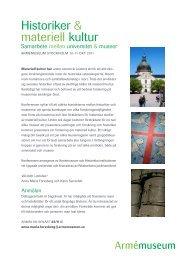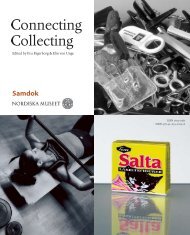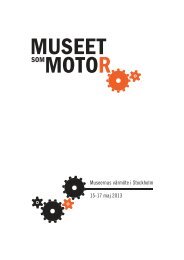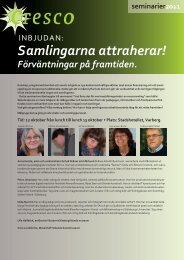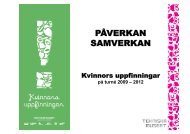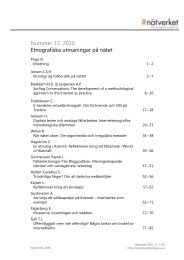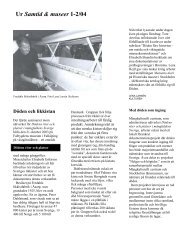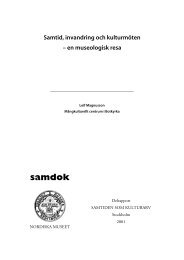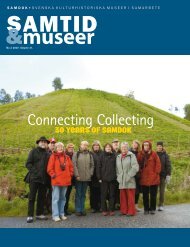Beskrivningens metodik. Om att sätta ord på det ... - Sveriges Museer
Beskrivningens metodik. Om att sätta ord på det ... - Sveriges Museer
Beskrivningens metodik. Om att sätta ord på det ... - Sveriges Museer
You also want an ePaper? Increase the reach of your titles
YUMPU automatically turns print PDFs into web optimized ePapers that Google loves.
analysis, the report, and the exhibition can be richer, and the archivalmaterial we leave behind will be fuller.The fact that it is easy to avoid working with <strong>det</strong>ailed descriptions,instead preferring brief field notes and more definable interviews,was something about which there was full agreement among theparticipants in the course Descriptions and Musealization, arranged bySamdok and the N<strong>ord</strong>iska Museet in November 1999. Earlier courseson method (and the subsequent books) have dealt with topics suchas interview techniques, artefacts, and photographic documentation.This time we had chosen to let the descriptions be the methodologicaltheme.In this book the authors discuss narrative as a genre and description asa method from various perspectives. The focus, however, is on ethnologicaldescription.A journalist’s task is to tell a story, not to present research findings,acc<strong>ord</strong>ing to Anders Sundelin in “Narrative as Deception”. Sundelinemphasizes the importance of being honest when telling a story.Along with exactness of <strong>det</strong>ail, being convinced that what one is describingis true when one is describing it gives the text credibility andlegitimacy. Anders Sundelin often proceeds from a scene which servesas a starting point for the story he wants to tell, and this, in his opinion,makes the story alive.In her article “Descriptions: Communicating What You Have Seenand Heard”, Annette Rosengren draws <strong>att</strong>ention to what she finds tobe the great similarities between documentary narrative, for example,in film and journalism, and the documentation work of Swedish museums.One such similarity is that the work in both cases proceeds fromthe assumption that it is meaningful to learn about people’s reality.Annette Rosengren claims that we often reduce our descriptions toshort sentences in field diaries, when we should instead emphasize anddevelop the method. The ideal description should be able to give asense of presence, visualization, and well-chosen <strong>det</strong>ails. She reasonsabout ethnological descriptions which, besides being readable today,78



